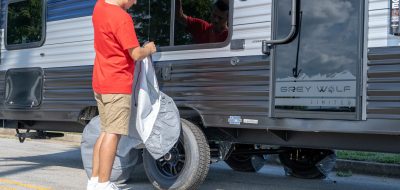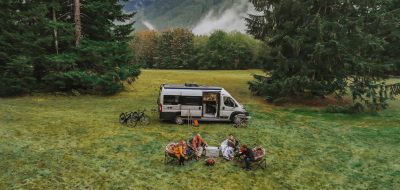 Nothing could be finer than to see the Carolinas
Nothing could be finer than to see the Carolinas
by Lee Barnsthan
The glow of the rising sun peeping over the lush green mountains slowly begins to filter into your cozy RV bedroom. Donning a light jacket, the air is surprisingly crisp as you step from your RV into the cool mountain air. The calendar says it’s late May, but nestled high in the hills of western North Carolina, summer’s heat has not yet arrived. Today begins your exploration of North and South Carolina—an adventure that will end at the shore. Both states boast pristine beaches, history spanning hundreds of years and beautiful mountainous areas.
“Within a day’s trip, you could go from the cool, deep water of a mountain lake to the sultry weather of the Atlantic coast,” said Dawn Dawson-House, Director of Public Relations for the South Carolina Department of Parks, Recreation & Tourism. She was speaking about her state, but she could just as well have been talking about her northern neighbor.
“We’ve got diversity, it’s a big selling point,” said Walton Ferrell, Public Relations Director for the North Carolina Division of Tourism.
Both states’ beaches are beauties to behold. In the north, one can take a five-day self-guided tour of lighthouses and sites where pirates frequented. To the south, there is Myrtle Beach and the Grand Strand, a 60-mile stretch that features great shell collecting and sun bathing as well as golf, historic tours, entertainment complexes and the world’s largest collection of American sculpture, at Brookgreen Gardens.
Another well-known aspect of North Carolina is its furniture-making industry. More than 60 percent of all furniture made in the USA is made within a 200-mile radius of the central part of the state. If this were a country, its capital would be High Point, the “Home Furnishings Capital of the World”. With more than 70 furniture stores within its city limits, one can find just about any style, type, model, material and manufacturer in the High Point area. Be sure to check out the High Point Museum and Historical Park, where exhibits tell the story of how the large Quaker population settled here and made High Point the furniture juggernaut it is. The museum also has been named the first “Senior Friendly” museum in the state. Jazz aficionados are also going to want to check out John Coltrane’s digs.
On the North Carolina side of the Great Smoky Mountains in Asheville is the Biltmore Estate, known as “America’s Largest Home”. In the grand tradition of the mansions of Newport, R.I., the Biltmore is another example of Vanderbilt opulence and wealth. There are 65 fireplaces, a 70,000-gallon indoor pool, 23,000-volume library, bowling alley, priceless art and antiques in its 250 rooms. The estate also includes a winery, exquisite gardens and a working farm village that shows visitors how the estate sustained itself.
Because both states are part of the original 13 colonies, there is more history than just Civil War-era plantations and slaves. Dawson-House said South Carolina calls itself “The Battleground of Freedom” because more Revolutionary War battles were fought here than in any other state. The archaeological site in Dorchester lets the public get involved with excavating a colonial town. Charleston, S.C. also has 73 pre-Revolutionary buildings, 136 structures from the late 1700s and more than 600 others built before the 1840s.
If you prefer the Civil War era, there are plenty of plantations, such as Middleton and Hampton in South Carolina and Stagville in Durham, N.C., where re-enactors re-create the lives of plantation owners and slaves.
North Carolina offers various self-guided, five-day tours to such historical sites as Andy Griffith’s hometown of Mount Airy, the places Hollywood came to shoot the movies “Bull Durham” and “Forrest Gump,” Greensboro’s historic Museum, home to exhibits about O. Henry and Edward R. Murrow; and the North Carolina School of the Arts, which houses the second largest non-commercial collection of films.
Motorsports fans will want to pay a visit to the two capitals of NASCAR Country, Lowe’s Motor Speedway in Charlotte, N.C., or Darlington (S.C.) Raceway. Park in the infield and enjoy the fastest growing sport in America. There are almost 100 auto-racing tracks in these two states, 69 of which are in North Carolina. Twelve months a year there is an auto race somewhere in North or South Carolina. Both Lowe’s and Darlington also feature museums dedicated to the sport and its history.
The states’ golf courses provide welcome (and quieter) alternatives for all handicaps. The most famous is Pinehurst No.2 in North Carolina, considered one of the greatest in the world. The first, however, was Tanglewood, in the mountain resort area of Linville. South Carolina has professional tour stops in Hilton Head and Myrtle Beach as well as a seniors event at Kiawah in 2007. South Carolina also offers courses inside the vast state park system, and the Myrtle Beach area is a golf mecca, with over 80 courses to play.
Most state parks, especially in South Carolina, offer RV-friendly campsites. Many are in the mountains, with spectacular views of pristine, untouched land. North Carolina offers the Blue Ridge Parkway and the Smokies, full of waterfalls, hiking trails, trout fishing and skiing. In the south, state parks such as Devils Fork, Oconee and Table Rock offer beauty tucked far away from civilization. These and other parks provide visitors with a base of operations that allows for easy exploration.
For additional North Carolina tourist information, please visit www.visitnc.com or call (800) VISITNC (800-847-4862). For additional South Carolina tourist information, please visit www.discoversouthcarolina.com or call (803) 734-1700 between 8:30 a.m. and 5:30 p.m. Eastern Time.




